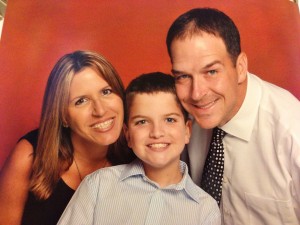
When radio personality Froggy was diagnosed with acromegaly 10 years ago, he made it his personal mission to educate the public — as well as primary care physicians — on this rare and unexpected disease.
Late last year, the Endocrine Society published its clinical practice guideline (CPG) on acromegaly in The Journal of Clinical Endocrinology & Metabolism, laying out recommendations and suggestions for diagnosing and treating this chronic condition that causes the hands, feet, and facial features to grow, and if left unchecked, can cause serious health problems and increased mortality. It’s a rare disease, affecting three people out of a million each year, and it’s tricky to deal with, since each patient presents with different symptoms.
But while this CPG is a valuable resource for creating a treatment plan, it’s often just as valuable to hear straight from those who suffer from acromegaly, especially when the nuances of this disease may be lost on the public and the primary care physicians they first go to when something’s wrong. And it’s even better when an acromegaly patient has a unique platform to make his voice heard.
Froggy is a radio personality on one of the most popular nationally syndicated radio shows in the country, Elvis Duran and the Morning Show. And by all accounts, Froggy has it all: a great life with a wonderful family in sunny south Florida and a job that allows him to use his radio-perfect voice (he got the name “Froggy” because his voice is so deep) to make people laugh and grin during their morning routines. But it hasn’t always been sunshine and smiles for Froggy.
Froggy has had acromegaly for 10 years, maybe longer, since the disorder is so slow-moving that it can make it difficult to diagnose or even detect. Now, on the heels of the Society’s CPG, the Hormone Health Network has partnered with Novartis and Froggy’s Straight Talk Acromegaly program, so that Froggy can share his story.
“If one person hears me talk about the symptoms that I had or the things that I was experiencing, and they’re experiencing the same thing, then that’s exactly why we stared doing this program.”
— Froggy, radio personality, Elvis Duran and the Morning Show
“The Network has joined forces with Froggy and Novartis to help support their Straight Talk Acromegaly disease awareness campaign by participating in a live Twitter chat and sharing the Network’s acromegaly online resources to help empower patients and their loved ones who may feel that something isn’t quite right,” says Cheretta Clerkley, director of the Hormone Health Network. “By hearing Froggy’s story, patients may be able to identify and seek medical treatment. It’s important that the Network supports this awareness campaign because there are 117 new cases a year and if we can help patients to seek treatment with their healthcare provider and start a dialogue about the symptoms they may be experiencing they can begin the necessary treatment.”
“[Straight Talk Acromegaly is] giving me a broader reach to be able to talk to people who didn’t know about the disease,” Froggy says, “and I’ve been saying from the beginning, if I can help one person — if one person hears me talk about the symptoms that I had or the things that I was experiencing, and they’re experiencing the same thing, then that’s exactly why we stared doing this program.”
Growing Pains
When the disease first started, or when Froggy first noticed something was wrong, he was tired constantly, suffered from intense headaches, and he sweat profusely. But all these things he attributed to one thing or another, whether it was work-related (a radio personality has odd hours to keep) or simply getting older. Even the sweating could have been explained by living in Florida. After all, in medicine, common things happen commonly. “It happens over such a long period of time that you don’t realize it,” Froggy says, “and you write it off to aging.”
But Froggy had a difficult time continuing to write the symptoms off . The tiredness, the headaches, everything began to “take a toll” on him, so he did what any modern-day patient would do. He went online. “For the first time in my life I saw the word ‘acromegaly,’” he says. He also saw that the best — really the only — treatment for acromegaly is brain surgery. The Endocrine Society recommends surgery as the first course of action as well, since successful surgery can immediately lower growth hormone levels. But that can be hard for some patients to digest. “I remember seeing ‘brain surgery,’ closing the browser, closing the keyboard tray, and getting up and walking away from the computer,” Froggy says.
Froggy went on with his life, continuing to feel awful. He gained a lot of weight. His hands grew so much that he had to have his wedding ring resized four times. His feet grew from a size 10 to a size 14. His jaw grew so much that he was almost unrecognizable to his friends. His protruding jaw made it difficult to eat or even speak, which is pretty devastating to a guy who talks for a living. But all of this was an extremely slow process, not some sort of Kafkaesque transformation, so people who saw Froggy every day, like his wife, didn’t notice the changes much. (He also admits that he became adept at hiding his symptoms because he was afraid to face the fact that something was wrong.) Froggy himself didn’t even realize his speech had changed until he listened to old tapes of himself.

All of this, and he still didn’t know why. As it happens, it was a Jeopardy clue that gave him the answer. His mother had been watching the game show and seen the clue: “A disease that causes enlargement of the hands, feet, forehead, and lower jaw.” The answer: “What is acromegaly?”
When his mother called and told him about what she’d seen, Froggy knew he had to do something. “When she said that word,” he says, “it was like chills went over me.”
Getting a Diagnosis
Froggy made an appointment with his primary care physician the week after that phone call from his mother and told the doctor that he thought he had acromegaly, armed with the knowledge he gained from his own research, especially from the Novartis site, acromegalyinfo.com. “It was so informative that it gave me something to lean on,” Froggy says, “and when I went to the doctor, I could at least speak somewhat intelligently about what I thought I had.”
But his doctor wasn’t so sure. “She said, ‘No, I don’t think that’s what you have,’” he says, “and I said ‘Well, why?’ ” The reason was that the primary care physician had never seen an actual case of acromegaly in 20 years. Convinced he had acromegaly, Froggy persisted and asked his physician to send him for additional testing. He had a MRI that showed nothing wrong, but then he went for insulin-like growth factor-1 (IGF-1) testing with an endocrinologist, and he finally got his answer. “I knew my numbers were supposed to be around 200, 250,” Froggy says. “When we got my numbers back I was over 1,200. That was the day I was diagnosed with acromegaly.”
A scary diagnosis, to be sure, but Froggy says he was relieved. When he peeked at the chart the nurse had left in the exam room and saw that eye-popping number, he looked at his wife and said, “Well, I got it.” “I felt like there was a weight lifted off my shoulders,” he says. “There were so many [things] that were answered by that number, by that test, that when we walked out of that office, I went to play golf.”
The next step was surgery, the brain surgery that had scared Froggy from even looking at the word “acromegaly” before. Froggy underwent his brain surgery in 2010 at the University of Florida to have the pituitary adenoma removed, then had to have colon surgery to remove the polyps caused by acromegaly, then had reconstructive surgery on his jaw in 2011. Three separate surgeries, all from a tiny tumor.
After This Break
There is no cure for acromegaly, even with surgery. Patients have a chance for remission, but according to Laurence Kennedy, MD, chairman of the endocrinology department at the Cleveland Clinic and Froggy’s endocrinologist, the likelihood of that happening is only about 50%, so a lifelong regimen of drugs is needed to control the growth hormone (GH) and IGF levels. The Society’s CPG also recommends radiation therapy in patients with persistent tumor tissue after surgery or in cases in which medication is ineffective.
“Once you’ve come so far, the key is to be your own advocate. No one knows your body better than you do.”
— Froggy
Patients also have to relearn to do some things, as Froggy found out. After the surgery to correct his jaw, he had to almost reteach himself how to eat without biting his tongue and form particular sounds when he was speaking, so that he could talk at a quick pace. “My mouth muscles in my face and my jaw were trained to move a different way,” Froggy says, “so then after surgery, now everything’s in a different place.
“It was a complete readjustment period,” he continues, “that probably went on for a couple months after that.”
Simple things made difficult. And because of that and the fact that acromegaly is a chronic condition, it can be daunting for patients who have to live with it. But Froggy found comfort in his family, who make sure he takes his medications regularly; his work family, who threw him a party in New York; and online support groups like Acromegaly Community, which provides information and offers tips for living with acromegaly, as well as friendly support through peer-to-peer networks and message boards.

And Froggy says that while a support group is great for the mental battle with acromegaly, the most important thing to do is stay on top of it by taking medications and visiting the endocrinologist regularly to get tested. “If I don’t stay up on my numbers now and stay up with my endocrinologist,” he says, “I could end up back where I was again. I’d have to start all over again.”
Froggy now wears the original wedding ring his wife gave him in 2002, the size shoes he wore “years ago,” the same size clothes he wore in high school.
“Once you’ve come so far,” Froggy continues, “the key is to be your own advocate. No one knows your body better than you do.”
Up Next
Acromegaly is still considered a rare disease, especially to the public and maybe even primary care physicians. Froggy’s primary care physician had never seen a case in her entire medical career, after all.
Froggy’s goal with Straight Talk Acromegaly is to spread awareness of the disease to patients and doctors alike. “I remember how lost I felt when I didn’t know what to do,” he says. “I didn’t know what was wrong.”
He says that he wants even dentists and oral surgeons to be aware of the disease, since his own acromegaly is what caused him to have to have braces as a young man. “Just to be aware of it and to have that as one of your checklist points and say ‘Does this person have acromegaly?’ and send them for the right test,” he says, “It’s easy to find if you go get the right test.”
But Kennedy says the disease is more “uncommon” than “rare” to endocrinologists. “It’s actually quite common to those with interest in pituitary gland disorders,” he says.
“[Kennedy] told me if he had passed me on the street, he would have known I had it,” Froggy says.
Kennedy has been treating acromegaly for 38 years, and in that time he has seen some major advancements in the diagnosis and treatment of the disorder, such as the ability to image the pituitary gland and the “rediscovery” of microsurgery on the pituitary gland. Drugs that reduce GH and IGF-1 levels have been developed. “We have more arrows in our quiver, so to speak,” Kennedy says.
“Some doctors are so well versed in it that I think they do know,” Froggy says. “But that’s what I’m trying to do. My goal is to try to [talk to] not only people like me and people who think they’re experiencing odd side eff ects, but at the same time, to get doctors to know more about acromegaly.”
And he’s already seeing results. Froggy says someone reached out to him through Facebook after she heard his story on the radio. She told her best friend about it, and soon after, he was officially diagnosed. “That is why I’m doing this,” he says. “That’s one life that is changed, that’s one person who doesn’t have to go through ‘What the hell is going on with me?’ That’s the whole driving process behind this.”
— Bagley is the associate editor of Endocrine News. He wrote about exercise and diabetes in the November issue.

